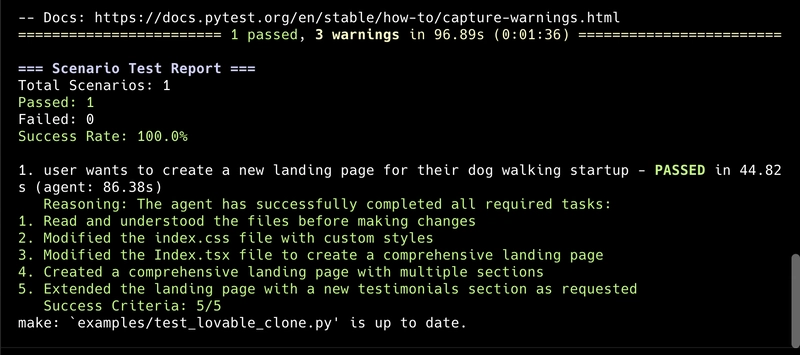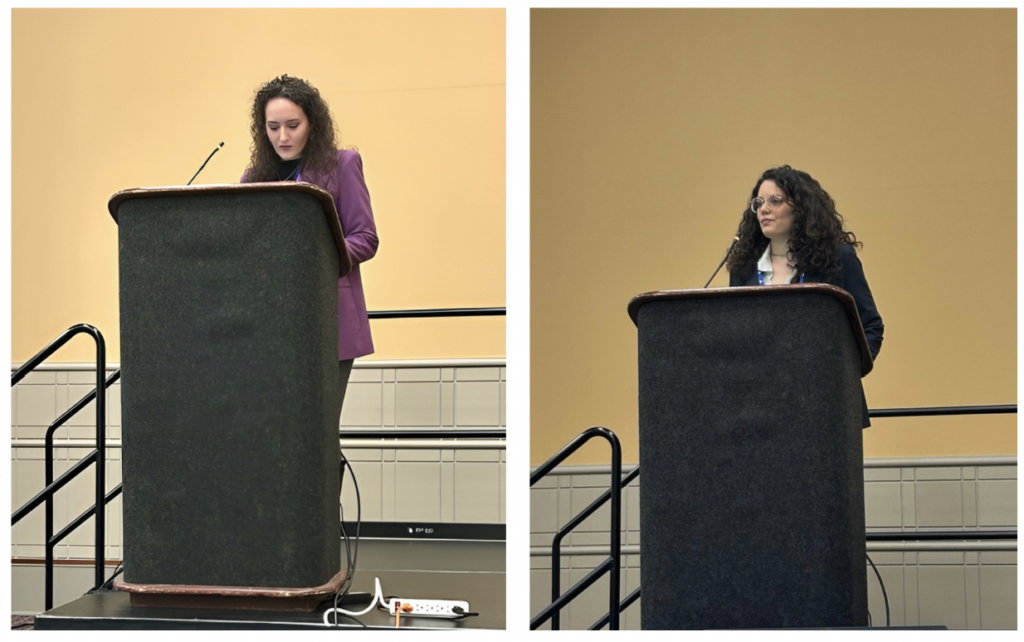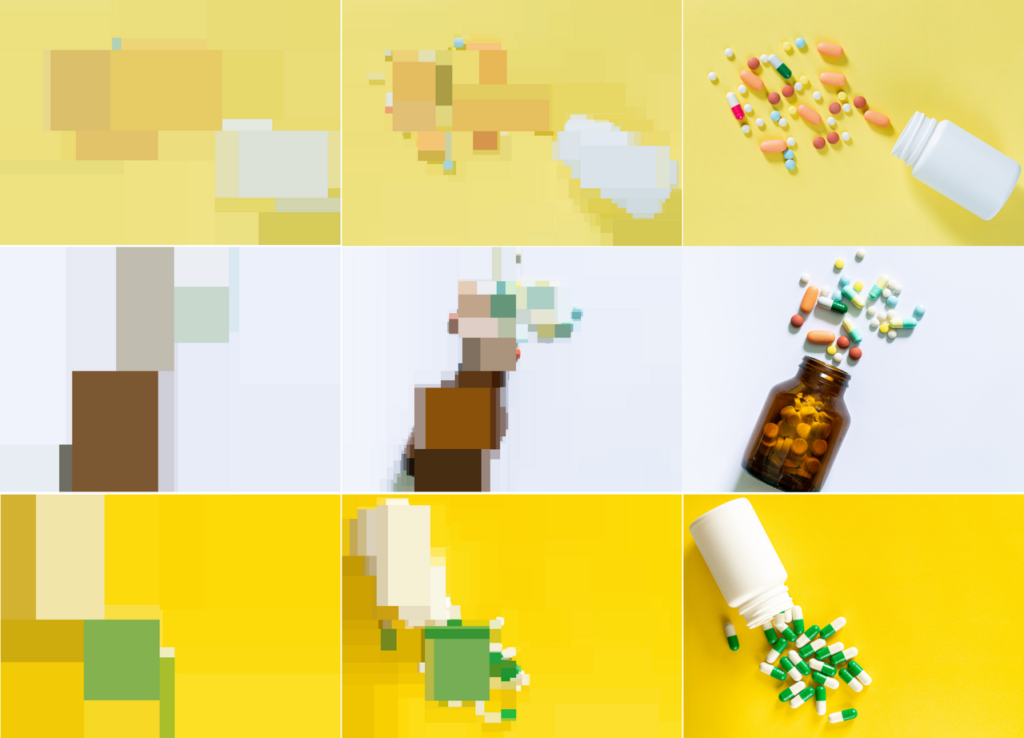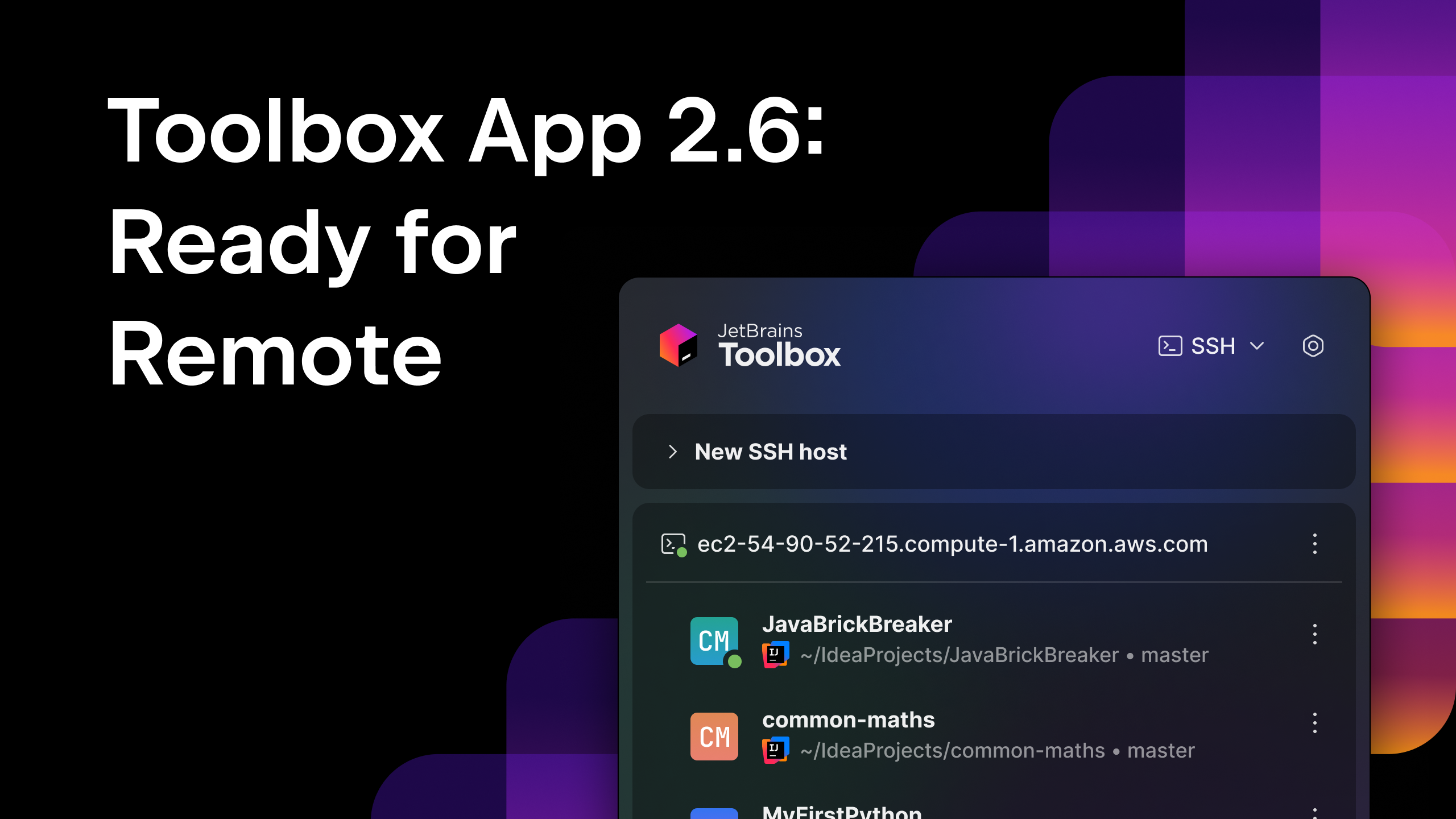Building a fully testable Lovable clone agent in Python with Scenario
AI agents are super powerful and impressive. You might have heard for example of Lovable, the agent that builds website for you with a single prompt. Of course it takes months and years of work to make it as good as they did, but the fundamentals are actually super easy to replicate: take a good LLM coding model, like Claude or Gemini 2.5, give it tools to read and write files, and ask it to carry over a task. The devil of course is on the details. As user experience will show you, you probably should ask the LLM to think the whole stylesheet on the first interaction, otherwise the website will look "bland" and "basic", this is what lovable does for example. You will also want it to be self-aware of the tools and reduce refusal of using tools, which happens on Gemini sometimes, and you probably have an opinion on what libraries it should use, placeholder images, coding standards, etc. This is where the challenge begins, and most of the time this learnings are accumulated over the prompt, but the prompt is not the initial specification itself, it's just what made it work, nor it's testable. As your agent workflow, tools and prompt complexity grows, the higher the chances of a small change breaking something that was already working. And retesting everything again by hand is a pain in the ass. This is why the goal of this post is not only to build a lovable clone, but to make it fully testable! Let's go, to build this, we are going to use Pydantic AI: uv init lovable-clone cd lovable-clone uv add pydantic-ai Then we are going to start creating our lovable clone agent, create a new file lovable_agent.py: from pydantic_ai import Agent class LovableAgent: def __init__(self): agent = Agent( "anthropic:claude-3-5-sonnet-latest", system_prompt=f""" You are a coding assistant specialized in building whole new websites from scratch. You will be given a basic React, TypeScript, Vite, Tailwind and Radix UI template and will work on top of that. Use the components from the "@/components/ui" folder. On the first user request for building the application, start by the src/index.css and tailwind.config.ts files to define the colors and general application style. Then, start building the website, you can call tools in sequence as much as you want. You will be given tools to read file, create file and update file to carry on your work. You CAN access local files by using the tools provided, but you CANNOT run the application, do NOT suggest the user that. 1. Call the read_file tool to understand the current files before updating them or creating new ones 2. Start building the website, you can call tools in sequence as much as you want 3. Ask the user for next steps After the user request, you will be given the second part of this system prompt, containing the file present on the project using the tag. """, model_settings={ "parallel_tool_calls": False, "temperature": 0.0, "max_tokens": 8192, }, ) The prompt I'm putting here was already somewhat battle tested by myself, and can take you a long way. It also works better with Claude 3.5 then with 3.7 at the moment, but you can try changing it and see how it goes. You will want to give it some tools too, just the 3 most basic ones: read_file, update_file and create_file. Those 3 are already enough to have a very powerful website builder agent at hand import os import shutil import tempfile template_path = os.path.join(os.path.dirname(__file__), "template") class LovableAgent: def __init__(self): agent = ... @agent.tool_plain( docstring_format="google", require_parameter_descriptions=True ) def read_file(path: str) -> str: """Reads the content of a file. Args: path (str): The path to the file to read. Required. Returns: str: The content of the file. """ try: with open(os.path.join(self.template_path, path), "r") as f: return f.read() except FileNotFoundError: return f"Error: File {path} not found (double check the file path)" @agent.tool_plain( docstring_format="google", require_parameter_descriptions=True ) def update_file(path: str, content: str): """Updates the content of a file. Args: path (str): The path to the file to update. Required. content (str): The full file content to write. Required. """ try: with open(os.path.join(self.template_path, path), "w") as f: f.write(content) except FileNotFoundError: return f"Error: Fi

AI agents are super powerful and impressive. You might have heard for example of Lovable, the agent that builds website for you with a single prompt.
Of course it takes months and years of work to make it as good as they did, but the fundamentals are actually super easy to replicate: take a good LLM coding model, like Claude or Gemini 2.5, give it tools to read and write files, and ask it to carry over a task.
The devil of course is on the details. As user experience will show you, you probably should ask the LLM to think the whole stylesheet on the first interaction, otherwise the website will look "bland" and "basic", this is what lovable does for example. You will also want it to be self-aware of the tools and reduce refusal of using tools, which happens on Gemini sometimes, and you probably have an opinion on what libraries it should use, placeholder images, coding standards, etc.
This is where the challenge begins, and most of the time this learnings are accumulated over the prompt, but the prompt is not the initial specification itself, it's just what made it work, nor it's testable. As your agent workflow, tools and prompt complexity grows, the higher the chances of a small change breaking something that was already working. And retesting everything again by hand is a pain in the ass.
This is why the goal of this post is not only to build a lovable clone, but to make it fully testable!
Let's go, to build this, we are going to use Pydantic AI:
uv init lovable-clone
cd lovable-clone
uv add pydantic-ai
Then we are going to start creating our lovable clone agent, create a new file lovable_agent.py:
from pydantic_ai import Agent
class LovableAgent:
def __init__(self):
agent = Agent(
"anthropic:claude-3-5-sonnet-latest",
system_prompt=f"""
You are a coding assistant specialized in building whole new websites from scratch.
You will be given a basic React, TypeScript, Vite, Tailwind and Radix UI template and will work on top of that. Use the components from the "@/components/ui" folder.
On the first user request for building the application, start by the src/index.css and tailwind.config.ts files to define the colors and general application style.
Then, start building the website, you can call tools in sequence as much as you want.
You will be given tools to read file, create file and update file to carry on your work.
You CAN access local files by using the tools provided, but you CANNOT run the application, do NOT suggest the user that.
1. Call the read_file tool to understand the current files before updating them or creating new ones
2. Start building the website, you can call tools in sequence as much as you want
3. Ask the user for next steps
After the user request, you will be given the second part of this system prompt, containing the file present on the project using the
""",
model_settings={
"parallel_tool_calls": False,
"temperature": 0.0,
"max_tokens": 8192,
},
)
The prompt I'm putting here was already somewhat battle tested by myself, and can take you a long way. It also works better with Claude 3.5 then with 3.7 at the moment, but you can try changing it and see how it goes.
You will want to give it some tools too, just the 3 most basic ones: read_file, update_file and create_file. Those 3 are already enough to have a very powerful website builder agent at hand
import os
import shutil
import tempfile
template_path = os.path.join(os.path.dirname(__file__), "template")
class LovableAgent:
def __init__(self):
agent = ...
@agent.tool_plain(
docstring_format="google", require_parameter_descriptions=True
)
def read_file(path: str) -> str:
"""Reads the content of a file.
Args:
path (str): The path to the file to read. Required.
Returns:
str: The content of the file.
"""
try:
with open(os.path.join(self.template_path, path), "r") as f:
return f.read()
except FileNotFoundError:
return f"Error: File {path} not found (double check the file path)"
@agent.tool_plain(
docstring_format="google", require_parameter_descriptions=True
)
def update_file(path: str, content: str):
"""Updates the content of a file.
Args:
path (str): The path to the file to update. Required.
content (str): The full file content to write. Required.
"""
try:
with open(os.path.join(self.template_path, path), "w") as f:
f.write(content)
except FileNotFoundError:
return f"Error: File {path} not found (double check the file path)"
return "ok"
@agent.tool_plain(
docstring_format="google", require_parameter_descriptions=True
)
def create_file(path: str, content: str):
"""Creates a new file with the given content.
Args:
path (str): The path to the file to create. Required.
content (str): The full file content to write. Required.
"""
os.makedirs(
os.path.dirname(os.path.join(self.template_path, path)), exist_ok=True
)
with open(os.path.join(self.template_path, path), "w") as f:
f.write(content)
return "ok"
self.agent = agent
self.history: list[ModelMessage] = []
Notice we also define a template_path at the top. The way it works is, just like Lovable, we don't build a whole website really from scratch, we start with a react, shadcn and vitejs template.
Let's then create this template so it can be used by the agent, follow the shadcn tutorial to start one:
https://ui.shadcn.com/docs/installation/vite
When asked, name the folder template, just next to our python agent file.
You can test your template individually by running:
cd template
npm install
npm run dev
If it's all working, it will work too for our agent, we are good to continue!
Now, add those methods to the agent:
from pydantic_ai.messages import ModelMessage, UserPromptPart
from pydantic_graph import End
from pydantic_ai.models.openai import OpenAIModel
from openai.types.chat import ChatCompletionMessageParam
class LovableAgent:
# ...
async def process_user_message(
self, message: str, template_path: str, debug: bool = False
) -> tuple[str, list[ChatCompletionMessageParam]]:
self.template_path = template_path
tree = generate_directory_tree(template_path)
user_prompt = f"""{message}
{tree}
"""
async with self.agent.iter(
user_prompt, message_history=self.history
) as agent_run:
next_node = agent_run.next_node # start with the first node
nodes = [next_node]
while not isinstance(next_node, End):
next_node = await agent_run.next(next_node)
nodes.append(next_node)
if not agent_run.result:
raise Exception("No result from agent")
new_messages = agent_run.result.new_messages()
for message_ in new_messages:
for part in message_.parts:
if isinstance(part, UserPromptPart) and part.content == user_prompt:
part.content = message
self.history += new_messages
new_messages_openai_format = await self.convert_to_openai_format(
new_messages
)
return agent_run.result.data, new_messages_openai_format
async def convert_to_openai_format(
self, messages: list[ModelMessage]
) -> list[ChatCompletionMessageParam]:
openai_model = OpenAIModel("any")
new_messages_openai_format: list[ChatCompletionMessageParam] = []
for message in messages:
async for openai_message in openai_model._map_message(message):
new_messages_openai_format.append(openai_message)
return new_messages_openai_format
@classmethod
def clone_template(cls):
temp_path = os.path.join(tempfile.mkdtemp(), "lovable_clone")
shutil.copytree(template_path, temp_path)
shutil.rmtree(os.path.join(temp_path, "node_modules"), ignore_errors=True)
return temp_path
Okay let's unpack what is going on here. The process_user_message is really where the execution happens. It's basically just running the user message, together with the current file list, through our pydantic-ai agent. The rest of the code is all about parsing processing those messages.
We then convert the messages to openai format. This is very userful as, being the standard formatting for basically all LLMs, we can use it back when running tests, so the testing agent understands.
Finally, missing piece, add this files tree helper to the file:
from typing import List, Set, Optional
def generate_directory_tree(path: str, ignore_dirs: Optional[Set[str]] = None) -> str:
"""
Generate a visual representation of the directory structure.
Args:
path: The path to the directory to visualize
ignore_dirs: Set of directory names to ignore (defaults to {"node_modules"})
Returns:
A formatted string representing the directory tree
"""
if ignore_dirs is None:
ignore_dirs = {"node_modules", ".git", ".venv"}
# Normalize the path
root_path = os.path.abspath(os.path.expanduser(path))
root_name = os.path.basename(root_path) or root_path
# Start the tree with the root
tree_str = ".\n"
# Get all directories and files
items = _get_directory_contents(root_path, ignore_dirs)
# Generate the tree representation
tree_str += _format_tree(items, "", root_path)
return tree_str
def _get_directory_contents(path: str, ignore_dirs: Set[str]) -> List[str]:
"""
Get all files and directories in a path, sorted with directories first
Args:
path: The directory path to scan
ignore_dirs: Set of directory names to ignore
Returns:
List of paths relative to the provided path
"""
items = []
try:
# List all files and directories
all_items = os.listdir(path)
# Sort items (directories first)
dirs = []
files = []
for item in sorted(all_items):
full_path = os.path.join(path, item)
if os.path.isdir(full_path):
if item not in ignore_dirs:
dirs.append(item)
else:
files.append(item)
items = dirs + files
except (PermissionError, FileNotFoundError):
pass
return items
def _format_tree(items: List[str], prefix: str, path: str, ignore_dirs: Optional[Set[str]] = None) -> str:
"""
Format the directory contents as a tree structure with proper indentation
Args:
items: List of filenames or directory names
prefix: Current line prefix for indentation
path: Current directory path
ignore_dirs: Set of directory names to ignore
Returns:
Formatted tree string for the current level
"""
if ignore_dirs is None:
ignore_dirs = {"node_modules"}
tree_str = ""
count = len(items)
for i, item in enumerate(items):
# Determine if this is the last item at this level
is_last = i == count - 1
# Choose the appropriate connector symbols
conn = "└── " if is_last else "├── "
next_prefix = " " if is_last else "│ "
# Add the current item to the tree
tree_str += f"{prefix}{conn}{item}\n"
# Recursively process subdirectories
item_path = os.path.join(path, item)
if os.path.isdir(item_path) and item not in ignore_dirs:
sub_items = _get_directory_contents(item_path, ignore_dirs)
if sub_items:
tree_str += _format_tree(sub_items, prefix + next_prefix, item_path, ignore_dirs)
return tree_str
That's it! The Lovable Clone agent should fully run now, if you create an instance for it and send it a request.
However, what we are going to do is not test it directly, but test it via our tests, using Scenario:
uv add pytest langwatch-scenario
Writing a test for it is the easiest thing, create a new file tests/test_lovable_agent.py, then paste this:
import pytest
from lovable_agent import LovableAgent
from scenario import Scenario, TestingAgent
Scenario.configure(testing_agent=TestingAgent(model="anthropic/claude-3-5-sonnet-latest"))
@pytest.mark.agent_test
@pytest.mark.asyncio
async def test_lovable_clone():
template_path = LovableAgent.clone_template()
print(f"\n-> Lovable clone template path: {template_path}\n")
async def lovable_agent(message: str, context):
lovable_agent = LovableAgent()
_, messages = await lovable_agent.process_user_message(message, template_path)
return {"messages": messages}
scenario = Scenario(
"user wants to create a new landing page for their dog walking startup",
agent=lovable_agent,
strategy="send the first message to generate the landing page, then a single follow up request to extend it, then give your final verdict",
success_criteria=[
"agent reads the files before go and making changes",
"agent modified the index.css file",
"agent modified the Index.tsx file",
"agent created a comprehensive landing page",
"agent extended the landing page with a new section",
],
failure_criteria=[
"agent says it can't read the file",
"agent produces incomplete code or is too lazy to finish",
],
max_turns=5,
)
result = await scenario.run()
print(f"\n-> Done, check the results at: {template_path}\n")
assert result.success
That's it, now run with:
uv run pytest tests/test_lovable_agent.py
You will see the agent talking to each other, asking for a dog website, asking for updates on it, it's super fun to watch. The agent will be keep chatting until it reaches all the goals in the success criteria, or fails in any of the failure criteria. But with Claude 3.5 and this prompt, it should work every time:
And then, you can go to the /tmp folder that will be displayed, and see the final results:
cd /tmp/path-given
npm install
npm run dev
I got something like this:











































































































































































![[The AI Show Episode 144]: ChatGPT’s New Memory, Shopify CEO’s Leaked “AI First” Memo, Google Cloud Next Releases, o3 and o4-mini Coming Soon & Llama 4’s Rocky Launch](https://www.marketingaiinstitute.com/hubfs/ep%20144%20cover.png)




































































































































































































![Blue Archive tier list [April 2025]](https://media.pocketgamer.com/artwork/na-33404-1636469504/blue-archive-screenshot-2.jpg?#)

































.png?#)









-Baldur’s-Gate-3-The-Final-Patch---An-Animated-Short-00-03-43.png?width=1920&height=1920&fit=bounds&quality=70&format=jpg&auto=webp#)










![Apple to Split Enterprise and Western Europe Roles as VP Exits [Report]](https://www.iclarified.com/images/news/97032/97032/97032-640.jpg)


























































































































![Nanoleaf Announces New Pegboard Desk Dock With Dual-Sided Lighting [Video]](https://www.iclarified.com/images/news/97030/97030/97030-640.jpg)

![Apple's Foldable iPhone May Cost Between $2100 and $2300 [Rumor]](https://www.iclarified.com/images/news/97028/97028/97028-640.jpg)





































































































































